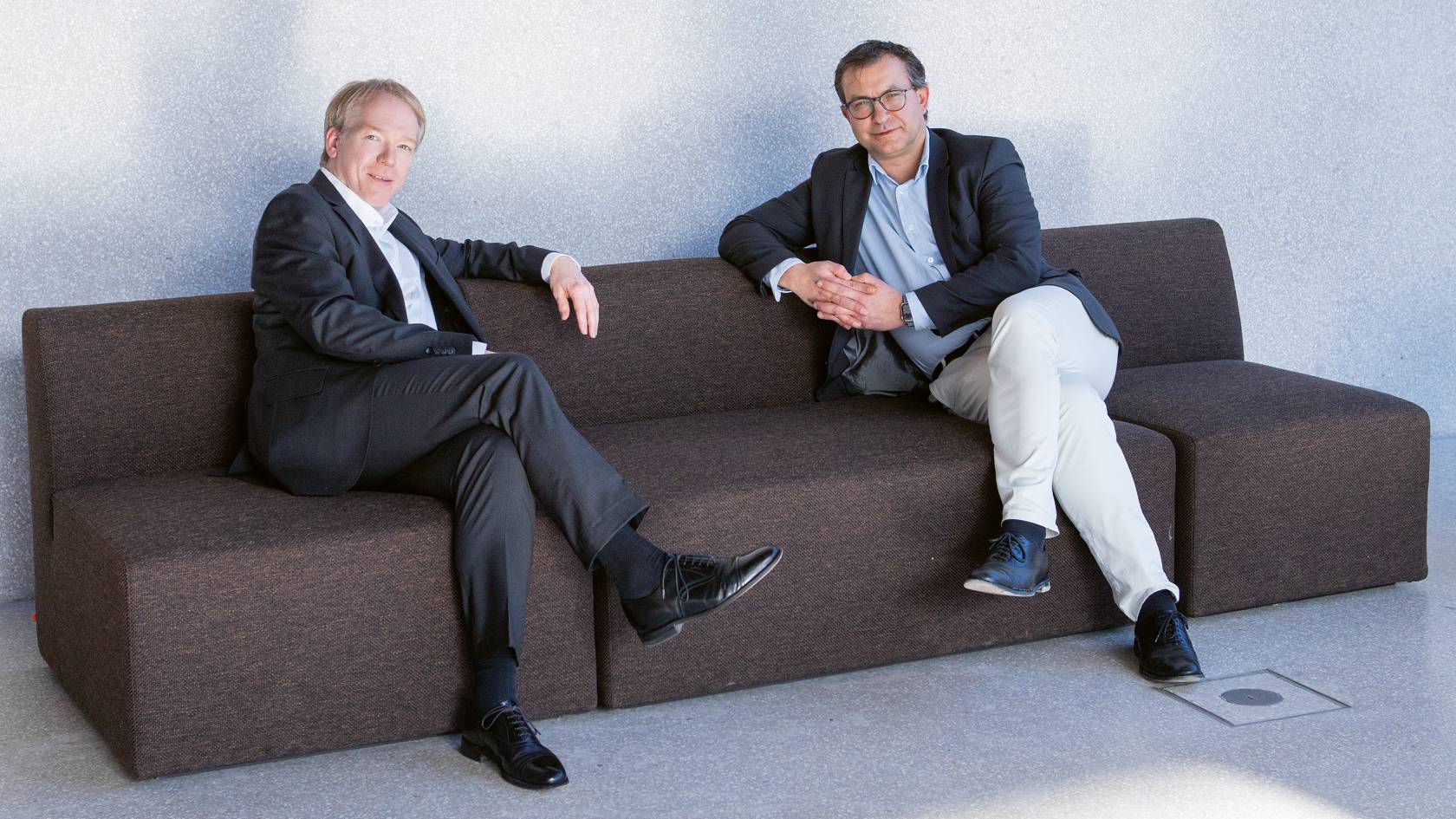
Holistic process and organizational consulting
Benefit from many years of experience and in-depth practical knowledge
ATOSS Consulting is a dedicated specialist for modern workforce management. We ensure that you will make the very best use of your most essential, and at the same time most expensive resource – your employees. More impactful and efficient workforce management reduces costs and translates as greater flexibility and productivity – the sound foundation for sustainable success.
ATOSS Consulting supports companies in sustainably optimizing processes and organizations
Optimizing workflows and standardizing processes
We advise and consult on processes and organizational structure to support companies from every sector and of every size finding the optimum structure for their workforce scheduling and time management processes along the entire value chain. In the process, we will help you to optimize your workflows and standardize processes. This will enable you to react to changes even faster in future and improve your competitiveness over the long term.
We want to join forces with companies in building a solid foundation – for greater flexibility in the organization of working time and HR processes.

Our range of services is as multifaceted as the demands you make on modern workforce management. The focus of our process and organizational consulting is on the following topic areas:
Our expertise
Working Time Flexibilization
The three levers to flexible working models
There are three aspects or levers to making work models more flexible. For example, working models differ in their flexibility in terms of space, time and subject matter. A combination of the three levers makes it possible to compensate for fluctuations and volatility, ensure employee satisfaction and guarantee cost efficiency.
Spatial flexibility: when the location is not important
More and more people working in Germany have to be mobile for professional reasons - whether as commuters or when travelling to customers, meetings or trade fairs. Some of this work-related travel is unavoidable and remains a necessity. However, another part can be avoided by working models in which employees are not tied to a specific workplace but can work from home or via desk sharing. Technology promotes and simplifies location-independent working, for example through virtual teams, cloud solutions and video conferencing.
Time flexibility: when demand determines working time
Every company strives to react quickly and efficiently to short-term or unforeseeable fluctuations in demand. However, across all sectors, most companies continue to rely on rigid working time models which, if they are not fully utilized, lead to overstaffing and thus to unproductivity and inefficiency. By contrast, understaffing occurs when there is greater demand, which is usually compensated for by overtime. In some cases, enormous wage mark-ups and overburdening of employees are accepted.
Fluctuating needs require greater flexibility. Annual working time accounts are a good way of allowing employees to "build up" hours during peak demand periods and then to "celebrate" this credit when the workload is lower. With the alternative option "work on call", employees hold themselves ready for a possible shift. If there is no need, they receive a certain percentage of their fixed salary for being on call. This means that any work that arises is done as needed instead of at rigidly fixed times.
Professional flexibility: when everyone can do everything
Personnel flexibility is achieved not only through working time related measures, but also mainly through interdepartmental and cross-departmental employee deployment. This enables employees to change their job or activity at very short notice. This is only possible through multiple qualifications. Employees learn important additional skills that make them fit for other machines, workplaces and departmental structures. This enables flexible staffing of workplaces. Different employees with the required qualifications are available for different tasks, so that capacity bottlenecks can be compensated across departments. An integrated workforce management solution helps you manage qualifications and creates cross-departmental transparency
Three steps to flexible employee deployment
If all the requirements of a work model are successfully covered, the foundations are laid for a needs-based and sustainable deployment of employees. This is also to the advantage of the employees: they now have the opportunity to adapt their working methods to their personal habits and their current situation in life. And with a healthy work-life balance, they are demonstrably more satisfied, more productive and are less likely to drop out.
The following three steps point the way to sustainable and flexible employee deployment.
- The first step is to analyze the status quo. The main focus is on the requirements of your business model and your employees.
- In addition, a comparison is made with current possibilities and restrictions, for example through company agreements and collective bargaining agreements.
- Since the introduction of new working models usually changes the corporate culture noticeably and is associated with changes for many employees, the process should be accompanied by a qualified and company specific change management.
Designing Working Time Models
Whereas most companies are in line with the times when it comes to their manufacturing processes and their product mix, and perform meticulous analyses and optimization, their shift or duty rosters often remain unchanged. Demand peaks are simply compensated for by expensive additional shifts or the use of temporary workers, while overstaffing is tacitly accepted. Working time models, however, should also be analyzed from time to time and adapted to new conditions, just like the vertical range of manufacturing, product and variant diversity or machines and systems. After all, this also has a significant impact on efficiency and value creation. But just how does one go about developing an optimal working time model?
Five steps to an optimal working time model
- How much capacity is required?
In order to develop an optimal working time model, or an ideal shift or duty roster, the first step consists in determining the required manufacturing capacities, while taking the possible plant capacities into account. Therefrom it is derived to what extent and over what period of time the personnel capacities are required. Moreover, the required flexibility of staffing time and staffing levels are defined. - How many employees are needed to meet the personnel requirements?
The personnel actually required can be calculated on the basis of the staffing requirements, whereby planned and unplanned absences (for example, due to vacation or illness) are also factored in. This second step also comprises an initial calculation of the additional and reduced costs compared to the current total personnel costs. - How must the shift plan be structured?
Depending on the required flexibility of the staffing time and staffing levels and the staffing requirements, the parameters are defined in order to adequately structure the duration of the duty schedule and shift cycle. Furthermore, the frequency of each shift in the cycle is determined. - How is the shift plan designed in detail?
As soon as the framework of the new duty schedule parameters is established, the individual shifts are distributed over the weeks and weekdays of the schedule, additionally extended by possible substitute shifts. Here, the main focus is on taking seasonally fluctuating staffing requirements into account. - How are employees assigned to the shifts?
Individual employees are assigned to predefined shifts in the duty schedule. On this basis, any additional personnel requirements can be derived. Finally, the new duty schedule is compared with the shift plans of other areas in order to ensure material flows.
- How much capacity is required?
Downtime Management
To ensure productivity is maintained over the long term, systematic downtime management helps to react adequately and cost-efficiently to short-term staff shortages or additional requirements. The incorrect calculation of "personnel buffers" and a low level of cross-divisional flexibility rank among the most frequent sources of errors in managing downtime and absences. In addition, there is usually a lack of transparency regarding required and existing qualifications in order to find suitable substitutes. A sound problem analysis helps to uncover such weaknesses.
There is no generally valid formula to compensate for downtime that could be universally applied to companies. All approaches and instruments have their advantages and disadvantages. A well-founded process analysis, tailored to your demands and requirements, helps to find an intelligent combination of measures that optimally meet your requirements. Downtime management always demands a customized concept.Successful downtime management in three steps
- Analysis of the reasons and frequency of staff shortfalls: The various types of absences must be accounted for and their frequencies determined.
- Based on the results, preventive measures are derived to minimize the various downtimes and absences and reduce their frequency.
- Concrete measures for downtime and absence management are defined and implemented in accordance with the business model and corporate culture.
Demand-driven workforce scheduling
The positive effects of a demand-driven workforce scheduling will quickly become apparent. While personnel expenses contract, service levels and production quality will be back on the upswing. Customer satisfaction and customer loyalty improve significantly. The result: savings of up to millions of euros - simply by opting for a workforce scheduling solution precisely attuned to demand.
Leveraging demand-driven workforce scheduling, manufacturing companies will achieve the best possible machine and employee utilization, relegating unnecessary shift supplements and cost-intensive production downtimes rapidly to the past. And when employees with the right qualifications are always planned in precisely, process effectiveness shifts into higher gear.
Retailers also stand to benefit appreciably from demand-driven workforce scheduling. Staff on the shop floor consistently in line with customer frequency guarantee high service levels, strengthen customer loyalty and secure conversion rates and sales.Managing complexity the smart way
Workforce scheduling is a complex undertaking. How can personnel requirements be determined if they not only fluctuate over the course of a week or year, but sometimes even hourly? How do you plan availabilities with regard to holidays, illness or other absence reasons? What legal requirements regarding working hours or collective bargaining requirements must be taken into account? Transparency with regard to demand and legal working time frameworks is absolutely essential in demand-driven planning. We are at your side in mastering this complexity efficiently.
Benefiting companies and employees alike
When taking workforce scheduling to the next level, the current planning should initially be analyzed and evaluated in detail. Improvements can be achieved, for example, by reorganizing working times or vacation periods. By taking specific vacation quotas into account in absence planning and gearing vacation approvals accordingly, over- and understaffing can be avoided. And when personnel deployment is adjusted to actual personnel requirements, fewer short-term changes to planning will occur. Your employees reciprocate - with higher job satisfaction, lower sickness rates and rising productivity.
Requirements Forecast
Better planning thanks to more accurate forecasts opens up greater scope in personnel management and planning, while reducing the time pressure to compensate for over- and understaffing. Furthermore, employees can be informed about additional shifts and shift cancellations at an early stage – benefitting everyone involved: Greater employee satisfaction goes hand in hand with lower sickness rates and greater overall productivity.
Demand drivers, forecast periods, trend factors, reference days and adequate performance indicators all determine the quality of workforce forecasting. Only if all of them are chosen correctly, will optimal workforce scheduling be possible. This is precisely where the experts at ATOSS Consulting enter the picture in analyzing the forecast of your personnel requirements and adapting it precisely to your company. Experience gained to date shows that forecasting accuracy can be elevated by up to 30% – and with it productivity and profitability.Process and potential analysis
Process weaknesses in human resources also incur productivity losses and prevent the capacity for smooth, agile action. Nevertheless, only few companies focus on this central value creation area. Addressing this situation, we will join forces with you to put your existing work processes, methods and documents revolving around workforce management on the test bench - and identify optimization opportunities. This thorough process analysis is geared to identifying development potential as a basis for decisions on the systematic optimization of your workforce management – for the benefit of the entire company.
The basis of the potential analysis is a detailed and objective recording of the status quo of the workforce management processes. The resources deployed and the process expenditure are quantified and qualitatively evaluated. On this foundation, recommendations for process optimization are developed, including the use of a state-of-the-art software solution. By comparing the status quo and the developed target processes, the savings are determined in the potential analysis and the qualitative benefit is evaluated. Based on an estimation of the required investments, a business case and an implementation plan are created.Optimizing business processes
Business process optimization is like a fitness regime for companies. And it begins with a status assessment. Before embarking on optimization, a workshop will be scheduled in which all the relevant processes relating to human resources are recorded. The recorded processes are then redesigned as best as possible, and precisely documented. This entails eliminating interfaces, appointing process owners as well as expedient IT support. A good business process is lean and features a clear distribution of tasks, in connection with few media gaps.
Change management
In actual practice, many change projects fail due to internal resistance. Fears and uncertainty arise among impacted employees, often due to a lack of information and communication. If the project fails and the initial situation is resumed, however, this leads to investment losses and dissatisfaction. By implementing effective change management, resistance can be reduced and acceptance of the change increased.
The goal of every change management process is the sustainably successful introduction of change throughout the company. In this case, innovations or changes are implemented across different company dimensions by means of a sensitive change management project.- Why is change important?
As long as the necessity of the change is not understandable and comprehensible for all concerned, acceptance will not arise! In order to support project success at an early stage, the goals must be clear and supported by everyone. - What can I implement when?
It is important that the conceptual design and the technical implementation for the realization are realistically planned right from the outset. This is the only way to achieve intermediate timeline and budget goals – and to celebrate them as partial successes. - How do I involve as many people as possible in the solution?
In order to achieve the greatest possible success, key stakeholders must be involved in the project at an early stage. In particular, stakeholders should not be confronted with decisions made in advance, but should be involved in the decision-making process. When introducing a workforce management system, for example, it will be vital to integrate planners, HR officers and IT people, as well as employee representatives into the project and to work with all of them in designing the future solution. Overall, all affected employees should be able to help shape the project. - How and when must I inform whom?
All the respective communication activities such as flyers, newsletters, information stands and events must be derived from the project objectives. Attention must also be given to the proper and expedient coordination of the different media, contents and events. - How do I empower my employees?
Employee acceptance of the new business processes and tools is a key prerequisite for project success. This can only be ensured if employees are specifically trained, introduced to and familiarized with the changes. - How will the project succeed?
In order to achieve the sustainable success of the project, it is also necessary to consistently pursue the further implementation. In this context, the synchronization of all activities and the expedient monitoring and controlling of priorities are of particular importance.
- Why is change important?
Holistic workforce management approach for measurable added value
We support you in the efficient, employee-oriented and demand-oriented management of your personnel. Customized and tailored precisely to your requirements, we make working time and shift models more flexible, streamline planning and administration processes and create workforce management transparency. It is crucial for the success of a workforce management project that the improvement measures cover the entire company – from process analysis to software implementation and downstream processes. How can you achieve this? We will show you how.
The holistic workforce management process from potential analysis to software implementation
Optimizing workforce management in three steps
Step 1: Process and potential analysis
The first question to be answered in a workforce management project is the resulting benefits. Which is why the first thing we do is to conduct process and potential analyses to identify change requirements. In the process, we record the status quo of the existing processes in your company, show you tried and tested, best practice solutions, draw up a business case and define the specific software requirements as well as the specifications.
Step 2: How can the maximum benefits be achieved?
We will develop a comprehensive workforce management concept customized to your organization and will execute specific optimizations. It factors in company agreements, defines the process design and records the organizational structure and role profiles. In the course of the optimization process, we will develop the appropriate working time regulations, shift model optimization and downtime management. We also support you with an overarching change management and communication concept to anchor the change resulting from workforce management optimization in your company.
The next step involves determining what your future workforce management should look like so that the company will benefit in the best possible way. In order to achieve this, we will develop a comprehensive workforce management concept customized to your organization and will execute specific optimizations.The concept includes a target definition and describes the project structure and the roadmap. It also factors in company agreements, defines the process design and records the organizational structure and role profiles. In the course of the optimization process, we will develop the appropriate working time regulations, shift model optimization and downtime management.
Already from this project phase going forward, we will accompany you with a comprehensive change management concept to anchor the change resulting from workforce management optimization in your company. In addition, we will also support you with a communication concept and its implementation.Step 3: Successful implementation
After these preparations, we will take your workforce management to the next level in terms of practical implementation. The complete software implementation is executed by the ATOSS Professional Services specialists: These experts perform quality monitoring, carry out an implementation check and are at your side in the continuous improvement process. In addition, the seasoned professionals from ATOSS Consulting will assist you with their many years of experience in project management.
Following successful implementation, we will go on to identify any new and open issues that need to be addressed for further optimization. Our consulting services also comprise a benefits analysis and a roadmap for sustainable optimization. This will ensure that your new workforce management delivers the maximum benefits.
Experience and practical knowledge gained from around 10,000 projects
Our consultants draw on over 30 years of experience and the in-depth know-how amassed in around 15,000 projects in the field of workforce management. We're at your side, supporting you from strategy through to practical implementation based on a systematic and proven process model. Many of our consultants have also gained experience in international strategy and management consulting - so naturally, these competencies are also at your disposal.
Our customers’ success stories speak for themselves
Our projects demonstrate that the average annual potential in the area of workforce management for a company with 1,000 employees is in the range of millions. Numerous customers have taken their very first steps into professional workforce management with a comprehensive potential analysis of their processes and possible optimizations.
That’s how workforce management delivers its fullest potential.

Are you looking for sound advice? I will be happy to help you!



